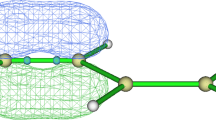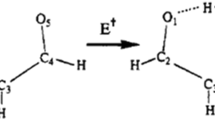Abstract
The inductive effect of methyl group has been quantified by expressing highest occupied molecular orbital (HOMO) and HOMO–1 energies of indole and a series of methylated indoles using a combination of graph theory (GT) and the Coulson–Longuett–Higgins perturbation method. By correlating these expressions with the corresponding Kohn–Sham orbital energies of the indoles obtained by density functional theory (DFT) calculation at the B3LYP/6–31+ +G(d,p) and M06–2X/6–31+ +G(d,p) levels of theory, the inductive effect parameter h Me has been estimated; the Coulomb integral α of π-conjugated carbon atom also comes out from the analysis. A correlation of the GT results with the HOMO and HOMO–1 energies obtained by the HF/STO–3G method yield almost the same values of h Me and α. Finally, when these estimated h Me and α are used to calculate the vertical ionization potentials of the methylated indoles in the series, an excellent correlation with experimental charge transfer transition energies of their molecular complexes with tetracyanoethylene is obtained which complies with Mulliken’s theory of charge transfer.

Inductive effect of methyl group has been quantified and the Coulomb integral α of π-conjugated C-atom has been estimated by comparing the graph theoretically calculated orbital energies of methylindoles with those obtained by HF/STO–3G, DFT/B3LYP/ 6–31++G(d,p) and DFT/M06–2X/6-31++G(d,p) methods. Results correlate well with experimental CT transition energies.








Similar content being viewed by others
References
Hohenberg P and Kohn W 1964 Phys. Rev. B 136 864
Kohn W and Sham L J 1965 Phys. Rev. A 140 1133
Jena N K, Srinivasu K and Ghosh S K 2012 J. Chem. Sci. 124 255
Srinivasu K and Ghosh S K 2011 J. Phys. Chem. C 115 1450
Ghosh C and Sarkar P 2007 J. Phys. Chem. Solids 68 1324
Mistri T, Dolai M, Chakroborty D, Khuda Bakshsh A R, Das K K and Ali M 2012 Org. Biomol. Chem. 10 2380
Webber B T, Per M C, Drumm D W, Hollenberg L C L and Russo S P 2012 Phys. Rev. B 85 14102
Tiwary A S and Mukherjee A K 2008 J. Mol. Struct-THEOCHEM 859 107
Gupta A, Singh R P, Singh V B, Mishra B K and Sathyamurthy N 2007 J. Chem. Sci. 119 457
Hückel E 1931 Z. Physik. 70 204
Jursic B S 2000 J. Mol. Struct-THEOCHEM 498 159
Hagebaum-Reignier D, Girardi R, Carissan Y and Humbel S 2007 J. Mol. Struct-THEOCHEM 817 99
Dias J R and Guirgis G A 2002 Croat. Chim. Acta 75 621
Hall G G 1977 Mol. Phys. 33 551
McClelland B J 1974 J. Chem. Soc. Farad. Tr. 70 1453
Sarkar J K and Mukherjee A K 1997 Mol. Phys. 90 903
Dias J R 2004 Croat. Chim. Acta 77 325
Dias J R 1987 Handbook of polycyclic hydrocarbons, Part A (1988 part B) (New York: Elsevier)
Dias J R and Aihara J 2009 Mol. Phys. 107 71
Dias J R 2011 Open Org. Chem. J. 5 112
Aihara J 2008 J. Phys. Chem. A 112 4383
Coulson C A and Longuet-Higgins H C 1947 Proc. R. Soc. (London) A 191 39
Mulliken R S 1952 J. Am. Chem. Soc. 74 811
Mulliken R S 1955 J. Chem. Phys. 23 397
Dias J R 1987 Can. J. Chem. 65 734
Datta K and Mukherjee A K 1997 Int. J. Quant. Chem. 65 199
Tiwary A S and Mukherjee A K 2008 Mol. Phys. 106 2271
Sreitwieser Jr. A 1961 Molecular orbital theory for organic chemists (New York: John Wiley), pp. 105
Demidovich B P and Marron I A 1976 Computational mathematics (Moscow: Mir), p. 176. See also Kurosh A G 1969 Higher Algebra (Moscow: Nauka)
Datta K K and Mukherjee A K 1989 Proc. Indian Acad. Sci. (Chem. Sci.) 101 499
Ulam S 1960 A collection of mathematical problems, (New York: Wiley) p. 29
Becke A D 1993 J. Chem. Phys. 98 5648
Lee C, Yang W and Parr R G 1988 Phys Rev. B 37 785
Frisch M J et al 2004 Gaussian 03, Revision D.01 (Wallingford CT: Gaussian, Inc.)
Zhao Y and Truhler D G 2008 Theor. Chem. Acc. 120 215
Nijamudheen A, Jose D, Shine A and Datta A 2012 J. Phys. Chem. Lett. 3 1493
Jissy A K, Ashik U P M and Datta A 2011 J. Phys. Chem. C 115 12530
Jose D and Datta A 2011 Cryst. Growth Des. 11 3137
Jissy A K and Datta A 2010 J. Phys. Chem B 114 15311
Frisch M J et al. 2009 Gaussian 09, Revision A.02: (Wallingford CT: Gaussian, Inc.)
Platt J R 1947 J. Chem. Phys. 15 419
Koopmans T A 1933 Physica 1 104
Foster R and Hanson P 1965 Tetrahedron 21 255
Acknowledgements
Authors are thankful to the learned reviewers for their valuable comments.
Author information
Authors and Affiliations
Corresponding author
Rights and permissions
About this article
Cite this article
TIWARY, A.S., MUKHERJEE, A.K. Inductive effect of methyl group in a series of methylated indoles: A graph theoretical analysis in the light of density functional theory and correlation with experimental charge transfer transition energies. J Chem Sci 125, 905–912 (2013). https://doi.org/10.1007/s12039-013-0436-4
Received:
Revised:
Accepted:
Published:
Issue Date:
DOI: https://doi.org/10.1007/s12039-013-0436-4




